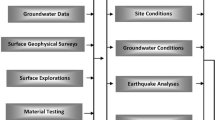Abstract
Hydrological information is a digital description for hydrological processes, which reflects the interaction among different elements for the surface system on earth. Conventional hydrological information processing methods to deal with such kind of uncertainty with mathematical assumptions does not tally with objective facts. Rough set theory is an effective mathematical tool treating imprecise, uncertain and incomplete data. It is based on the classification mechanism and assumes that classification is an equivalence relation in specific space while no external parameters are needed. By analyzing 13 factors that may affect precipitation at Lhasa station from 1972 to 1995, eight key factors affecting precipitation are identified and 58 decision rules are generated in this study. Data from 1996 to 2001 are used to evaluate performance of rough set model and the result shows that 83% of the test sets can be classified correctly and thus the rough set model can effectively address uncertainty of various factors affecting precipitation.



Similar content being viewed by others
References
Barbagallo S, Consoli S, Pappalardo N, Greco S, Zimbone SM (2006) Discovering reservoir operating rules by a rough set approach. Water Resources Management 20(1):19–36
Bodri L (1995) Short-term climate variability and its stochastic modeling. Theoretical and applied climatology 51(1–2):51–58
Bodri L, Cermák V (2000) Prediction of extreme precipitation using a neural network: application to summer flood occurrence in Moravia. Adv Eng Softw 31(5):311–321
Clarke RT (1980) Bivariate Gamma distribution for existing annual streamflow records from precipitation: some large-sample results. Water Resour Res 16(5):863–870
Golding BW (2000) Quantitative precipitation forecasting in the UK. J Hydrol 239(1–4):286–305
Grzymala-Busse JW (1988) Knowledge acquisition under uncertainty-A rough set approach. Journal of Intelligent and Robotic Systems 1(1):3–16
Habets F, LeMoigne P, Noilhan J (2004) On the utility of operational precipitation forecasts to served as input for streamflow forecasting. J Hydrol 293(1–4):270–288
Johnson DS (1974) Approximation algorithms for combinatorial problems. J Comput Syst Sci 9:256–278
Leung Y, Wu WZ, Zhang WX (2006) Knowledge acquisition in incomplete information systems: A rough set approach. Eur J Oper Res 168(1):164–180
Li LF, Wang JF, Cao ZD (2008) An information-fusion method to identify pattern of spatial heterogeneity for improving the accuracy of estimation. Journal of Stochastic Environmental Research and Risk Assessment 22(6):689–704
Liu GJ, Zhu Y (2006) Credit assessment of contractors: a rough set method. Tsinghua Science & Technology 11(3):357–362
Øhrn A (1999) Discernibility and rough sets in medicine: tools and applications, PhD thesis, Department of Computer and Information Science, Norwegian University of Science and Technology, Trondheim, Norway. NTNU report
Øhrn A (2000) ROSETTA Technical Reference Manual, Knowledge Systems Group, Department of Computer and Information Science, Norwegian University of Science and Technology (NTNU), Trondheim, Norway
Pawlak Z (1982) Rough set. Int J Comput Inform Sci 11(5):341–356
Pawlak Z, Grzymala-Busse J, Slowinski R, Ziarko W (1995) Rough sets. Commun ACM 38(11):88–95
Shreedhar M, Vincent G, Roland KPr (2004) Treatment of precipitation uncertainty in rainfall-runoff modelling: A fuzzy set approach. Adv Water Resour 27(9):889–898
Wagener T, Hoshin VG (2005) Model identification for hydrological forecasting under uncertainty. Stochastic Environ Res Risk Assessment 19(6):378–387
Wang X, Yang J, Jensen R, Liu X (2006) Rough set feature selection and rule induction for prediction of malignancy degree in brain glioma. Comput Methods Programs Biomed 83(2):147–156
Witlox F, Tindemans H (2004) The application of rough sets analysis in activity-based modeling: opportunities and constraints. Expert Systems Appl 27(4):585–592
Acknowledgments
This study is financed by the “Jingshi Scholar” Leading Professor Program in Beijing Normal University, P. R. China. Valuable comments and suggestions on the manuscript from anonymous reviewers and editors are also greatly appreciated.
Author information
Authors and Affiliations
Corresponding author
Rights and permissions
About this article
Cite this article
Zhang, Z., Xu, Z. Rough set method to identify key factors affecting precipitation in Lhasa. Stoch Environ Res Risk Assess 23, 1181–1186 (2009). https://doi.org/10.1007/s00477-008-0291-x
Published:
Issue Date:
DOI: https://doi.org/10.1007/s00477-008-0291-x




